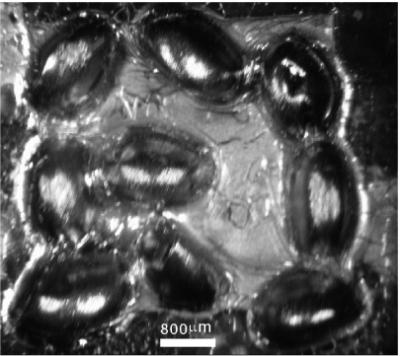Fly corneas prove viable for biomimetic surfaces, i.e. solar cells

Rows of tiny raised blowfly corneas may pave the way to easy manufacturing of bio-mimetic surfaces, surfaces that mimic the properties of biological tissues.
A team of Penn State researchers along with a professor from Universidad Autónomia de Madrid, Spain, developed a method to create macroscale molds or dies that retain nanoscale features replicated from the corneas of blowfly eyes. The image below depicts an array of nine blowfly corneas coated in nickel.
"Bioreplication began about 2001 or 2002," said Akhlesh Lakhtakia, Godfrey Binder Professor of Engineering Science and Mechanics. "All the techniques currently available are not conducive to mass replications. In many cases you can make as many replicas as you want, but you need an insect for each replication. This is not good for industrial purposes."
The researchers turned to blowfly eyes because of their potential application in the development of solar cells.
"We needed an object large enough to manipulate that still had nanoscale features," said Lakhtakia. "These eyes are perfect for making solar cells because they would collect more sunlight from a larger area rather than just light that falls directly on a flat surface."
To create the molds, the cross-disciplined team took blow fly corneas, placed them on a glass substrate and filled the back of the corneas with a silicone-based organic polymer, so that the metal covering they apply would not seep behind the eyes. Below is a close-up of a blowfly eye.
They then deposited nickel on the surface using a modified form of the "conformal-evaporated-film-by-rotation technique" described in a paper recently published in Bioinspiration & Biomimetics.
In this technique, the researchers thermally evaporate the material that forms the coating in a vacuum chamber. The object receiving the coating is fixed to a holder and rotated about once every two seconds.
The researchers used arrays of nine blowfly eyes coated with 250 nanometers of nickel. This initial template was then electroformed -- a method of electroplating -- to deposit nickel on the back to create a master template half a millimeter thick.
The master template can be used either as a die to stamp the pattern or as a mold. The intention is to use the master die/mold to produce not only daughter dies/molds, but to tile the templates so that they can imprint large areas. The researchers will probably expand their template to include 30 blowfly corneas.
"One of the nice things about a conformal coating like this is, it becomes nanograined," said Lakhtakia. "The surface of the die becomes very smooth so the polymer will probably not stick."
Polymer replicas produced thereafter by casting faithfully reproduced features of a few micrometers and larger in dimension, report the researchers.
The team is now looking at butterfly wings to understand how the surfaces create colors without pigment in their exploration to create potential surfaces for a variety of applications.
Source: Fly eye paves the way for manufacturing biomimetic surfaces
Related reading:
